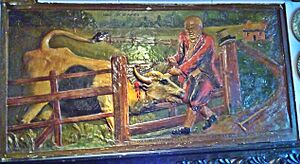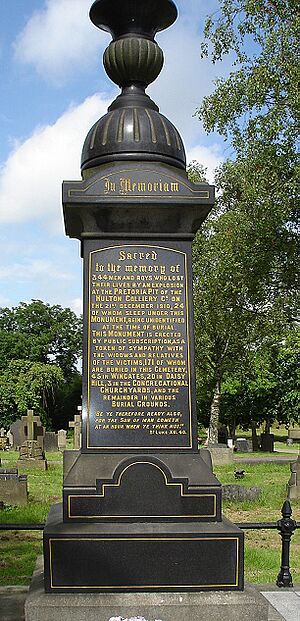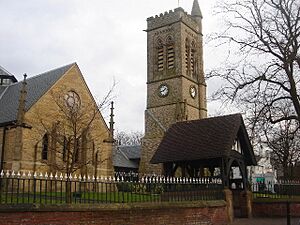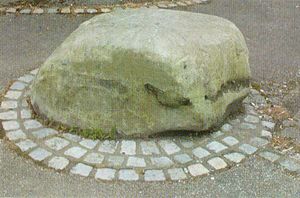Westhoughton facts for kids
Quick facts for kids Westhoughton |
|
|---|---|
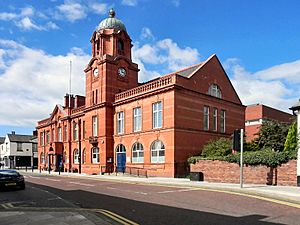 Westhoughton Town Hall, built 1903 |
|
| Population | 24,974 (2011 Census) |
| OS grid reference | SD6505 |
| Civil parish |
|
| Metropolitan borough |
|
| Metropolitan county | |
| Region | |
| Country | England |
| Sovereign state | United Kingdom |
| Post town | Bolton |
| Postcode district | BL5 |
| Dialling code | 01942 |
| Police | Greater Manchester |
| Fire | Greater Manchester |
| Ambulance | North West |
| EU Parliament | North West England |
| UK Parliament |
|
Westhoughton is a town and civil parish in Greater Manchester, England. It is about 4 miles southwest of Bolton. It is also 5 miles east of Wigan and 13 miles northwest of Manchester.
Westhoughton is part of the historic county of Lancashire. In the past, it was a busy center for coal mining, cotton-spinning, and making textiles. In 2011, about 24,974 people lived there.
The town includes several smaller villages and hamlets. These places have their own unique feel, sports teams, and facilities. Some of these areas are Wingates, White Horse, Over Hulton, Four Gates, Chequerbent, Hunger Hill, Snydale, Hart Common, Marsh Brook, Daisy Hill, and Dobb Brow.
Contents
- History of Westhoughton
- Local Government and Representation
- Geography and Natural Areas
- Population Changes in Westhoughton
- Education in Westhoughton
- Places of Worship
- Important Landmarks
- Getting Around Westhoughton
- Local Media and Library
- Famous People from Westhoughton
- Freedom of the Parish
- Images for kids
- See also
History of Westhoughton
What Does the Name Westhoughton Mean?
The name Westhoughton comes from Old English words. "Halh" means a nook or corner of land. "Tun" means a farm or settlement. So, Westhoughton means a "westerly settlement in a corner of land."
Over time, the name has been written in different ways. In 1210, it was called Halcton. Later, it became Westhalcton (1240) and Westhalghton (1292). In the 16th century, people started calling it Westhaughton and then Westhoughton.
Nicknames for People from Westhoughton
People from Westhoughton are sometimes called "Howfeners." They are also known as "Keawyeds," which means "cow heads." The town itself is even called "Keawyed City."
There is a funny old story about the "Keawyed" name. It says a farmer found his cow with its head stuck in a wooden gate. Instead of breaking the gate, he cut off the cow's head. This was because the gate was more expensive than the cow! This story was made popular again around the 1900s. Another village in Derbyshire, called Tideswell, has the same legend.
Early Conflicts: Banastre Rebellion
In 1315, a group of men met in Wingates, Westhoughton. They were led by Sir William Bradshaigh, Sir Henry Lea, and Sir Adam Banastre. They planned to fight against Sir Robert de Holland, a powerful leader. This conflict was called the Banastre Rebellion. Most of the main leaders died during this rebellion.
The English Civil War in Westhoughton
Westhoughton saw action during the English Civil War. On December 15, 1642, the Battle of Warcock Hill took place here. It was fought on Westhoughton Common. Lord Derby's Royalist forces fought against the Parliamentarians. The Parliamentarians were led by Captains Bradshaw, Venables, and Browne. They were captured by Lord Derby's Royalists.
It is thought that Prince Rupert of the Rhine gathered his troops in Westhoughton. This was before they attacked Bolton in 1644, which led to the Bolton Massacre. There was also fighting around Hunger Hill. A sword from the Civil War era was found in a garden in Chew Moor in the 1950s.
Industrial Revolution and Mining Disasters
The Industrial Revolution brought big changes to Westhoughton. On March 25, 1812, a group of Luddites burned down Rowe and Dunscough's Westhoughton Mill. This was one of Britain's first acts of terrorism. Twelve people were arrested. Four men were sentenced to death and publicly hanged. Nine others were sent to Australia. A blue plaque now marks the site of the mill.
By 1891, Westhoughton had many busy textile mills. Rose Hill Doubling Mill had over 8,000 spindles. Victoria Mill had 40,000 spindles. Other mills wove fabrics like shirtings, twills, and sateens. John Chadwick's Silk Mills made broad silks, ties, scarves, and handkerchiefs.
Coal mining was also very important. The Hulton Colliery Company opened several pits. Bank Pit No 3, also known as the Pretoria Pit, was the site of a terrible disaster. On December 21, 1910, 344 men and boys died in a firedamp explosion. This Pretoria Pit Disaster was one of the worst mining accidents in British history. A memorial from 1910 is now a protected historical site.
Local Government and Representation
How Westhoughton is Governed
For a long time, Westhoughton was a small area within Lancashire. In 1872, a local board was set up to manage the town. In 1894, this became the Westhoughton Urban District. The Westhoughton Town Hall was built in 1903. It replaced the old offices and was designed by Bradshaw and Gass.
In 1974, Westhoughton became part of the new Metropolitan Borough of Bolton in Greater Manchester. Today, six councillors represent Westhoughton on the Bolton council.
In 1985, Westhoughton became a town council. It has 18 town councillors who are elected from six different areas. Each year, the town council chooses a town mayor.
Parliamentary Representation
From 1885 to 1983, Westhoughton had its own Member of Parliament (MP). This MP represented the town in the UK Parliament. Since 1906, the area usually elected a Labour Party candidate. The last MP for Westhoughton was Roger Stott. After the Westhoughton area was changed in 1983, he became the MP for Wigan.
There have been talks about creating a Westhoughton constituency again. This would include Westhoughton, Blackrod, Hindley, Atherton, and parts of Horwich and Leigh.
Geography and Natural Areas
Westhoughton covers an area of about 4,341 acres. It is about 2 miles wide from north-east to south-west. It is nearly 3.5 miles long from northwest to south-east. The highest land is in the north-east, and it slopes down to the south-west.
The town includes several villages and hamlets. These include Wingates, White Horse, Over Hulton, Four Gates, Chequerbent, Hunger Hill, Snydale, Hart Common, Marsh Brook, Daisy Hill, and Dobb Brow.
Westhoughton has several Local Nature Reserves. These are special places for nature. You can find them at Hall Lee Bank Park, Cunningham Clough, and Eatock Lodge at Daisy Hill.
 |
Standish | Horwich | Bolton |  |
| Hindley, Ince-in-Makerfield, Wigan | Farnworth | |||
| Abram | Leigh | Atherton |
Population Changes in Westhoughton
| Population changes in Westhoughton since 1801 | |||||||||||||||||||||||||||||||||||||||||||||||||||||||||||||||||||||||
|---|---|---|---|---|---|---|---|---|---|---|---|---|---|---|---|---|---|---|---|---|---|---|---|---|---|---|---|---|---|---|---|---|---|---|---|---|---|---|---|---|---|---|---|---|---|---|---|---|---|---|---|---|---|---|---|---|---|---|---|---|---|---|---|---|---|---|---|---|---|---|---|
|
|
|
|||||||||||||||||||||||||||||||||||||||||||||||||||||||||||||||||||||
| Sources: | |||||||||||||||||||||||||||||||||||||||||||||||||||||||||||||||||||||||
Education in Westhoughton
Westhoughton has several primary schools and one high school. Some older schools have closed or joined together over the years. For example, St John's, Wingates CE Primary, and Fourgates County Primary schools closed in 2004. They combined to form The Gates CP School. Westhoughton CP School closed in 2008.
| School | Type/Status | Ofsted | Website |
|---|---|---|---|
| Eatock Primary School, Daisy Hill | Primary | 105202 | Official site: http://www.eatock.bolton.sch.uk/ |
| Sacred Heart R.C. Primary School | Primary | 105243 | Official site: http://www.sacred-heart.bolton.sch.uk/ |
| St George's C.E. Primary School | Primary | 131038 | Official site: http://www.st-georges.bolton.sch.uk/ |
| St James C.E. Primary School, Daisy Hill | Primary | 105209 | Official site: http://www.st-james-daisy-hill.bolton.sch.uk/ |
| St Thomas' C.E. School, Chequerbent | Primary | 105234 | Official site: http://www.st-thomas.bolton.sch.uk/ |
| The Gates Primary School | Primary | 133926 | Official site: http://www.thegates.ik.org/ |
| Washacre Primary School | Primary | 105199 | Official site: http://www.washacre.bolton.sch.uk/Pages/Home.aspx |
| St Bartholomew's C of E Primary School originally Westhoughton Parochial C.E. Primary School |
Primary | 105237 | Official site: https://www.st-barts.bolton.sch.uk/ |
| Westhoughton Primary School (closed 2008) | Primary | 105180 | Official site: http://www.westhoughton-cp.bolton.sch.uk/ |
| Westhoughton High School | Secondary | 105252 | Official site: http://www.westhoughton-high.bolton.sch.uk/ |
Places of Worship
Westhoughton's main church is Saint Bartholomew's. The first chapel was built in 1552. A new brick church was built in 1731, and a third in 1869–70. On November 28, 1990, the church was badly damaged by fire. However, its tower was saved and is now a Grade II listed building.
A fourth church was built and opened in 1995. It has a large organ with 1,256 pipes. Other Anglican churches in the area include St John the Evangelist in Wingates and Austin and Paley's St James' Church, Daisy Hill, which is a Grade II* listed building.
The Roman Catholic community goes to Sacred Heart Parish Church. The old church building was replaced with a new one that also has a church hall.
John Wesley, a famous religious leader, preached in Wingates in 1784. The first Methodist church was built in 1835. A stone from which Wesley preached was moved to Grove Lane Chapel. This chapel is now the church hall for Westhoughton Methodist Church.
Westhoughton also has other churches. These include a Pentecostal church, a United Reformed Church, and an independent church.
Important Landmarks
Snydle water tower was built in 1914. For many years, it was empty and falling apart. Now, it has been fixed up and turned into a private home. You can see it from the M61 motorway.
The Church of England School, built in 1861, is a Grade II listed building. It is now called St Bartholomew's Church of England Primary School.
The red brick and terracotta town hall and Carnegie library were built between 1902 and 1904. They were designed by Bradshaw & Gass.
Getting Around Westhoughton
Roads and Motorways
The M61 motorway runs through the northern part of Westhoughton. It has junctions 5 and 6 that serve the town. Other main roads like the A58 and the A6 also cross through Westhoughton.
The motorway cut off some areas like Hunger Hill and Chew Moor from the rest of Westhoughton. A new road called Snydale Way was built to connect these areas. This road was designed to be a future motorway, but the plan was never finished.
Train Stations
Westhoughton has two train stations: Westhoughton railway station and Daisy Hill railway station. Trains from these stations connect to Wigan Wallgate and Manchester. Trains from Daisy Hill go via Atherton, while trains from Westhoughton go via Bolton.
In 2013/14, over 500,000 passengers used Daisy Hill and Westhoughton stations. This shows how important they are for the town.
Buses and Trams
Electric trams used to run from Bolton to Westhoughton until 1947.
Today, all bus services in Westhoughton are part of Transport for Greater Manchester's Bee Network. Go North West operates service 520 and the frequent service 607. Diamond North West operates services 516, 521, and 559. Many of these services connect to Bolton Interchange for more bus and train options.
Local Media and Library
The Horwich and Westhoughton Journal was a local newspaper. It was published from 1925 to 1980.
The town's Carnegie library is behind the Town Hall. Its Carnegie Hall is used for meetings and other events. The library also has a small museum. It shows items related to the Pretoria Pit Disaster. There is also a large model of the original St Bartholomew's Parish Church, made from matchsticks.
Local news and TV shows come from BBC North West and ITV Granada. These signals are sent from the Winter Hill transmitting station nearby.
Local radio stations include BBC Radio Manchester, Heart North West, and Bolton FM.
Famous People from Westhoughton
- Robert Shaw (1927–1978) – A famous actor who appeared in movies like Jaws and The Sting. He was born in Westhoughton.
- Ethel Johnson – A sprinter who ran for England in the 1932 Summer Olympics.
- Jack Bruton (1903–1986) – A footballer who played for Bolton Wanderers and England.
- Francis Lee – A footballer who played for Manchester City and England.
- Maxine Peake - An actress born in Westhoughton.
- Sir Harry Kroto (1939-2016) - A chemist who won the Nobel Prize in 1996.
- Houghton Weavers – A folk music group that had TV and radio shows in the 1970s.
- Wingates Band - One of the most well-known brass bands in the UK, formed in 1873.
Freedom of the Parish
Some people and military groups have been given the special "Freedom of the Parish" of Westhoughton.
Individuals
- Peter L. Finch: March 5, 2019. He was a former Mayor of Westhoughton and Mayor of Bolton.
Images for kids
See also
 In Spanish: Westhoughton para niños
In Spanish: Westhoughton para niños



